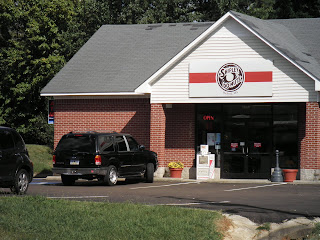 "Shipley's Do-Nuts, one of the few establishments in Oxford that failed its most recent restaurant inspection"
"Shipley's Do-Nuts, one of the few establishments in Oxford that failed its most recent restaurant inspection"By: Jennifer Wilson
Imagine this: It is Friday night. You are excited to get together with your friends and go out to eat. Everyone agrees on your favorite restaurant. You eat, you drink, and you go home happy. Five hours later, you are in your bathroom, violently ill, revisiting all of the wonderful things you consumed from that restaurant hours earlier. Later on in the week, your uncle, who works at the Lafayette County Health Department, mentions that the restaurant you dined at had recently been given a failing grade on its health inspection due to rodents and bugs found in the kitchen. The question is, if you had known about the failing grade before dinner, and the circumstances behind it, would you still have chosen to eat at your favorite restaurant?
Many people may not know, but full restaurant inspection reports are easily accessible and free for public viewing. These reports provide consumers with important findings about the places they may choose to eat. Citizens can view not only the overall grade a restaurant received from an inspection, but also the entire checklist utilized and the specific reasons why an establishment passed or failed. This information can help consumers decide which restaurants they consider safe to visit.
“I had no idea I could see all of that information online,” said Mary Coker, Ole Miss student.
“I would definitely want to know if my favorite place to eat had failed an inspection and if I could get sick from eating there. I can always find a new favorite,” she said.
There are a total of 36 factors that determine whether an establishment passes or fails an inspection. According to the details of a recent restaurant inspection record obtained at msdh.ms.gov, some of the items on an inspector’s checklist include: “Food Contact Surface Cleaned, Sanitized”, “Food Received at Proper Temperature” and “Insects, Rodents, and Animals Not Present.”
These three items, along with the other 33 questions listed on the report, help inspectors determine whether a restaurant is safely distributing food to consumers. According to msdh.ms.gov, one of the objectives of Mississippi’s food protection program is to identify any critical violations or risk factors that are present during the inspection. Critical violations are defined as “problems that consist of practices that could, if not controlled, result in a food borne illness.”
There are also violations listed on the inspection report that may not cause an immediate food borne threat to the public. Violations of this type include: “Permit/Last Inspection Posted” and “Sewage/Waste Water Properly Disposed.”
These and other such violations can contribute to an establishment receiving a failing grade on an inspection. Some people believe that violations of this nature lead to unfair representations of a restaurant.
Shipley's Do-Nuts, located on South Lamar Boulevard, failed its most recent restaurant inspection on Oct. 4, with a “C” grade, the lowest possible grade. The Mississippi State Department of Health website states that a C means “critical violations were found, but some or all were not corrected during the inspection,” or that “critical violations were repeated from recent previous inspections.”
Shipley’s received a “not in compliance” mark for the following points on the checklist: “Adequate Hand Washing Facilities Supplied/Accessible”, “Proper Cold Holding Temperatures”, “Hot And Cold Water Available/Adequate Pressure”, “Plumbing Installed/Proper Backflow Devices”, “Sewage/Waste Water Properly Disposed”, and “Permit/Last Inspection Posted.”
Ann, an employee of Shipley’s, who did not provide her last name, expressed that she does not feel that the failing grade provides an accurate representation of the establishment. Also, she believes that customers may get the wrong idea of Shipley’s ability to provide excellent customer service and satisfaction.
“I think we might have been graded improperly,” she said. “We have tried to take care of those issues and we always serve our customers to the highest quality.”
Christine Wilson is an Oxford resident and former server at many restaurants, including Chili’s Bar and Grill. She said that, in her experience with inspections, some violations on the report do not endanger the customer’s health, but they can cause the establishment to receive a failing grade.
“I would want to know why a restaurant failed the inspection,” she said. “When I worked at Chili’s, employees did not always remember to put lids on personal drink cups, and that counted against us as a violation. Apparently, there was a chance that not using a lid could somehow cause a transfer of germs to the customers. Honestly, we were not endangering anyone’s health.”
Although Shipley’s, along with City Grocery, McAlister’s Deli, and a few others, have all failed inspections this year, none of the businesses listed have had violations critical enough to close them down.
John Luke, director of food safety for the Mississippi State Health Department, said that it is up to the inspector to determine if an immediate closing of a restaurant is necessary.
A restaurant could be immediately shut down by, “any violation that has no temporary solution and could constitute a public health threat,” Luke said.
Certain health inspection violations can put consumers in danger and cause an establishment to lose its permit to serve food. It is up to the health officer to determine such threats. Otherwise, consumers can use the public inspection reports to decide if they want to eat at a specific restaurant.
“I’m the consumer, let me decide based on the actual facts of the report,” Wilson said.
Decide for yourself at http://msdh.ms.gov/food/default.aspx.
Word Count: 912
No comments:
Post a Comment